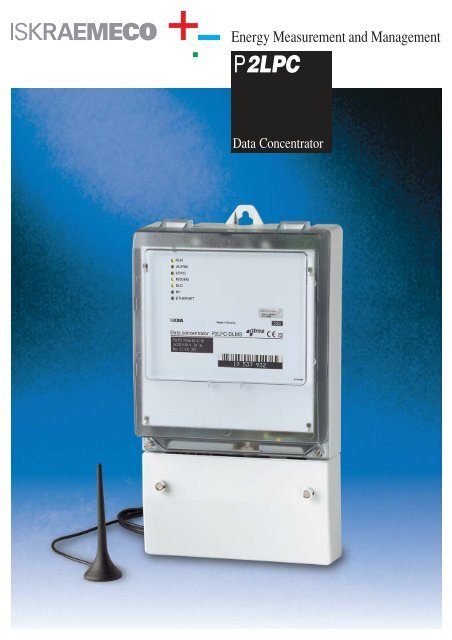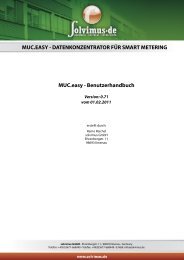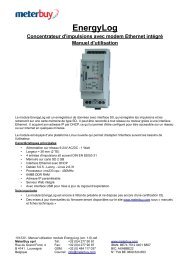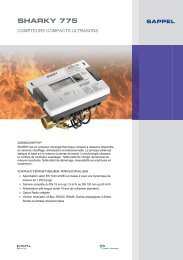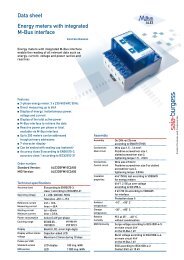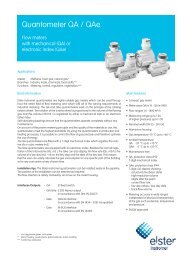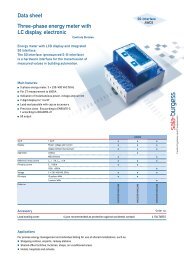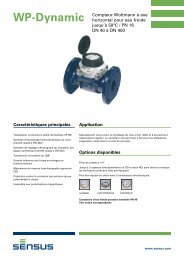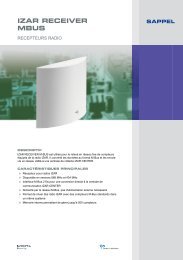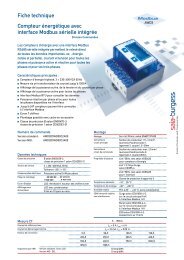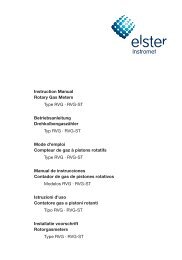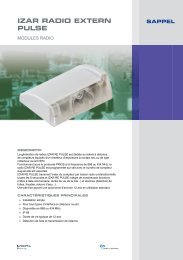P2LPC_prospect.pdf (ENG) - Iskraemeco
P2LPC_prospect.pdf (ENG) - Iskraemeco
P2LPC_prospect.pdf (ENG) - Iskraemeco
- No tags were found...
Create successful ePaper yourself
Turn your PDF publications into a flip-book with our unique Google optimized e-Paper software.
Energy Measurement and Management<strong>P2LPC</strong>Data Concentrator
<strong>P2LPC</strong>The <strong>P2LPC</strong> data concentrator is intended for automatic data collection from Mx351 and Mx371 family of electricity meters for AMRsystems. Communication with the electricity meters for AMR systems is performed via low-voltage network (DLC) in compliance withthe DLMS/COSEM communication protocol. <strong>P2LPC</strong> is based on a single board computer (SBC), running on the Microsoft WindowsCE operating system. Software application in <strong>P2LPC</strong> is responsible for finding, reading and managing two-way communications withthe electricity meters for AMR systems over DLC network, storing read data into the internal memory as well as for data transfer tothe collection centre. For communication with the data collecting centre different communication paths are available – PSTN, ISDN,GSM, GPRS and Ethernet, using standard Internet protocols – PPP, TCP/IP and FTP. Optionally <strong>P2LPC</strong> can be equipped with externalRF modem for reading electricity meters for AMR systems with built-in RF modem.<strong>P2LPC</strong> is designed and manufactured in conformity with the ISO 9001 standard.MAIN CHARACTERISTICS• Communication with themeters through the DLCnetwork or RF (optional)• ‘’Plug and Play’’ - automaticfinding, installing anddeinstalling of the meters• up to 1024 meters can behandled with one <strong>P2LPC</strong>• Saving of data into a nonvolatilememory• Communication with datacollecting centre over PSTN,ISDN, GSM, GPRS andEthernet• DLMS/COSEM protocol forcommunication with themeters• Standard Internet protocols(PPP, TCP/IP and FTP) forcommunication with the datacollecting centre• Microsoft Windows CEoperating system, file system• Remote monitoring andcontrolling of the <strong>P2LPC</strong>functioningCONCENTRATOR FUNCTIONThe <strong>P2LPC</strong> application runs on a single board computer (SBC) with the Microsoft Windows CEoperating system as a multithreading application. Multiple threads run simultaneously, each of them isresponsible for different functionalities of <strong>P2LPC</strong> which can be divided in the following parts:• DLC networking: detecting, installing and deinstalling of the meters, checking of the communicationquality. In case of bad conditions on the DLC network up to 7 meters (in one chain) can beautomatically set in a repeating mode for transferring data from and to the distant meters with whichdirect communication can not be established.• Meter readout: it is a periodic task performed by an adjustable time schedule. Results from themeters are stored into the files. Each meter has its own file for each month. DLMS/COSEM protocolis performed for communication with the meters. Simplified OSI model communication stack, definedin standards IEC 62056 – 46 (DATA LINK LAYER USING HDLC-PROTOCOL) and IEC 62056 – 52, isused. <strong>P2LPC</strong> uses a DLC modem on the physical layer. Special software driver takes care for sendingand receiving data to the DLC modem, making the DLC modem transparent for uppercommunications layers. DLMS uses HDLC protocol for data link layer. HDLC frames, type 2 (DLMSUA 1000-3, IEC 1334-4-42) are used. A standard DLMC/COSEM communication protocol isimplemented on the application layer.• Meter configuration and control: it is intended for remote changing of a tariff structure, load control,…• Data storage: Microsoft Windows CE file system is used for storing data. A new file is created foreach meter and for each month. There are three types of the files containing meters data: registers,load profile and events (log book). All files are stored on data storage memory. In order to savememory space the files can be compressed. Zipped file size for each meter and for each month takesabout 10kB (2kB registers, 6kB load profile and 2kB log book). 45 Mbytes of memory space arereserved for the meter data files. All data files, older than 3 months are deleted automatically.• Communication with data collecting centre is possible by a modem module or Ethernet LANconnection. For communication with the modem module the Remote Access Server – RAS is used.RAS uses the PPP protocol (RFC 1661) to establish and maintain peer-to-peer connection with a datacommunication centre. If the <strong>P2LPC</strong> is configured for connection to the GPRS network, <strong>P2LPC</strong>establishes connection to GPRS network and maintains it (redial/configure if it is lost). <strong>P2LPC</strong> in thisconfiguration acts as client (opposite to RAS where it acts as a server). On the transport layer aTCP/IP stack is used. On the upper layer of the TCP/IP stack, Windows socket interface is exposed tothe applications. These applications are an FTP server for transfering of meters readout files, SNMPfor management and NTP for time related functions. All these applications are standard Internetapplications defined in many RFCs. The files are received in the data collecting centre by the<strong>Iskraemeco</strong> SEP2Collect software and stored into database for further processing.
<strong>P2LPC</strong>Maintenance, programming as well as checking of <strong>P2LPC</strong> functioning can be performed locally via Ethernet interface or remotely via modem,GPRS or Ethernet interface. Various kinds of information, like a list of installed meters, data transactions, readout schedules, running operationsas well as data files can be observed on <strong>P2LPC</strong>. From a Command menu some actions can be forced, like finding new meters, deinstalling meters,forking meters and reading a schedule. Parameters as well as data files are saved in form of xml files. Statistics as well as logging informationare also saved on <strong>P2LPC</strong>. Operations performed by <strong>P2LPC</strong> application threads are logged into the text file. There are three types of logging information– errors, warnings and information. This file can be open to track thread execution. Statistics about the communication via DLC networkis also written into the text file. In this file you can see how many meters are installed on <strong>P2LPC</strong>, time stamps when meters were installed, andforked or lost from DLC network. Quality of data transfer over a DLC modem and availability of meters can also be seen on that file.DLC MODEMThe integrated DLC modem enables data transmission through thelow voltage network between the concentrator and the meters. Itsupports serial asynchronous communication with 4800 bit/s baudrate.The actual data transmission baud-rate through the low voltagegrid depends of the momentary conditions in the grid. DLC modemcontrol software supports sending and receiving data on all threephases simultaneously or on each phase separately.• Type of modulationSpread FSK (S-FSK) with two narrow band carriers (currently on93600 Hz and 83200 Hz – they can be also be matched to thecustomers requirements).• Baud rate1200 bps over grid (in severe conditions 300 bps possible)• The level of injected signalIn compliance with EN 50065 – wide band modulation• meters 134 dB/uV – one phase coupling• meters 128 dB/uV – three-phase coupling• <strong>P2LPC</strong> concentrator 128 dB/uV – three-phase coupling• Type of couplingCapacitive, electrically isolated• Type of communicationTwo-way, half-duplex• Communication structureMaster (data concentrator) – Slave (meter)• Modes of operationPolling, broadcast• Repeater modeSelf-adaptive, based on S/N measurement of both sub-carriers• Auto logging of nodesYes• Power consumption (DLC part)300 mA / 5 VEXTERNAL RF MODEMExternal RF modem can be used for communication with metersequipped with an RF modem. RF communication is based on amodified RADIAN 433 protocol. The protocol itself is the output ofRADIAN user group. Used frequency bands are license free, but theycan be adapted to the national or even customer’s needs. Nominalfrequency is 433.82 MHz. However, it can also be adapted to444.625 MHz, 444.925 MHz or 444.950 MHz.Nominal voltage . . . . . . . . . . . . . . . . . . . . .3x230/400 V, 3x400 Vother voltages on requestVoltage range . . . . . . . . . . . . . . . . . . . . . . . . . .0.8 Un ... 1.15 UnNominal frequency . . . . . . . . . . . . . . . . . . . . . . . .50 Hz or 60 HzOperating temperature . . . . . . . . . . . . . . . . . . . . .-20°C ... +60°CStorage temperature . . . . . . . . . . . . . . . . . . . . . . .-40°C ... +80°CPower consumption . . . . . . . . . . . . . . . . . . . . . . . . . . .25 W max
<strong>P2LPC</strong>BLOCK DIAGRAMLow voltagenetworkSupply unitEthernetSingle Board ComputerLAN adapterPSTN modemFTPFTPLANDLMSDLC ModemWindows CERS232 RS232ISDN adapterGSM modemFTPFTPTelephonenetworkGPRSFTPOVERALL AND FIXING DIMENSIONSOwing to periodical improvements of our products the supplied products can differ insome details from the data stated in the <strong>prospect</strong>us material.722.999.186 0509/15<strong>Iskraemeco</strong>, Energy Measurement and Management4000 Kranj, Savska loka 4, SloveniaTelephone: (+386 4) 206 40 00, Telefax: (+386 4) 206 43 76, http://www.iskraemeco.si, e-mail: info@iskraemeco.siPublished by <strong>Iskraemeco</strong>. Data subject to alteration without notice.


